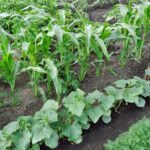Raised bed gardening vegetables offer a practical and efficient way to grow a wide variety of crops in your own backyard. Whether you have limited space, poor soil quality, or simply want to organize your garden more effectively, raised bed gardening can be the perfect solution. In this article, we will explore the concept and benefits of raised bed gardening vegetables, providing you with valuable information on how to get started and maximize your harvest.
One of the main advantages of raised bed gardening is its ability to create optimal growing conditions for vegetables. By elevating the soil level, you have greater control over its quality and composition. This means you can amend the soil specifically to suit the needs of different vegetable varieties, ensuring they receive the necessary nutrients and drainage. Additionally, raised beds tend to warm up quicker in spring and hold heat better during cooler nights, extending your growing season.
Another benefit of raised bed gardening is its versatility. Regardless of your available space or soil conditions, raised beds can be customized to fit any location. They can be built on top of existing soil or placed directly on hard surfaces like concrete or gravel. This flexibility allows for easy accessibility and makes it possible to create a garden oasis even in urban environments.
Throughout this article, we will guide you through every step of the process – from selecting the right location and constructing your raised bed to choosing suitable vegetable varieties and managing common issues. By following these tips and tricks, you’ll be well-equipped to create a thriving raised bed garden that will provide an abundance of fresh grown vegetables for years to come. So let’s dive in and uncover all that raised bed gardening has to offer.
Choosing the Perfect Location
Choosing the perfect location for your raised bed garden is crucial for its success. Sunlight, soil quality, and drainage are three key factors to consider when determining the ideal location for your raised bed.
Sunlight: Most vegetables need at least six hours of direct sunlight per day to thrive and produce a bountiful harvest. Before choosing a location for your raised bed, observe the sunlight patterns in your yard or garden. Look for an area that receives full sun throughout the day, avoiding spots that are shaded by trees or buildings. If necessary, trim back any overhanging branches that may cast shade on your raised bed.
Soil Quality: The quality of the soil in your raised bed is essential for good plant growth and productivity. Conduct a soil test to determine its pH level and nutrient content. Most vegetables prefer a slightly acidic soil with a pH range between 6 and 7. If needed, amend your soil with organic matter such as compost, well-rotted manure, or peat moss to improve its fertility, structure, and moisture-retaining capacity.
Drainage: Adequate drainage is crucial in preventing waterlogged soil, which can lead to root rot and other plant diseases. Avoid low-lying areas or locations prone to standing water when selecting the site for your raised bed garden. If you have poor natural drainage in your yard or garden, consider using raised beds with bottoms made from hardware cloth mesh to ensure proper drainage.
To summarize:
- Sunlight: Choose an area with at least six hours of direct sunlight per day.
- Soil Quality: Test the soil’s pH level and nutrient content; amend as necessary.
- Drainage: Avoid low-lying areas; use raised beds with proper draining mechanisms if needed.
By carefully considering these factors, you can provide your raised bed garden with the optimal growing conditions it needs for healthy and productive vegetable growth.
Designing and Building Your Raised Bed
Once you have chosen the perfect location for your raised bed garden, it’s time to start designing and building your raised bed. This step is crucial as it will determine the success and longevity of your vegetable garden. Fortunately, constructing a raised bed is relatively simple and requires only a few materials.
First, decide on the size and shape of your raised bed. The dimensions will depend on the space available and your personal preferences. It is generally recommended to keep the width of the bed no wider than 4 feet so that you can easily reach across from either side without stepping into the bed itself. The length can vary depending on the available space.
To outline the shape of your raised bed, use a string or hose to mark out the borders on the ground. Make sure they are straight and even before proceeding with construction.
Next, gather the materials needed for building your raised bed. One popular option is to use untreated cedar or redwood boards, which are naturally resistant to decay and insect infestations. Other alternatives include composite lumber or concrete blocks. Avoid using pressure-treated lumber, as it may leach harmful chemicals into the soil.
Once you have acquired all necessary materials, begin by constructing the frame of the raised bed. Start by attaching one end of each board together at 90-degree angles using galvanized screws or nails. Secure them with additional screws or nails at every 12 inches along each section for added stability.
After building the frame, place it within your marked-out borders on level ground or gently sloping terrain if preferred. Use a level tool to ensure that all sides are even before proceeding further.
With your frame in place, line the bottom of the raised bed with weed fabric or cardboard to prevent weeds from growing up into your vegetable garden. This step is especially important if your bed will be located on an area with existing vegetation.
Finally, add the soil mixture to your raised bed. A recommended blend consists of equal parts of compost, topsoil, and either perlite or vermiculite. Mix the components thoroughly before filling the raised bed with the soil mixture.
By following these step-by-step instructions and using the right materials, you can easily construct a raised bed suitable for vegetable gardening in no time. Building your own raised bed allows you to have complete control over the size, shape, and composition of your garden, ensuring optimal conditions for planting and growing a variety of vegetables.
Selecting the Right Vegetables
Size and Spacing
When selecting vegetables for your raised bed garden, it’s important to consider the size of the plants and how much space they will need to grow. Some vegetables, like tomatoes and cucumbers, can take up a lot of room with their sprawling vines. Others, like lettuce or radishes, require less space.
To maximize yield and prevent overcrowding, it’s important to pay attention to spacing recommendations for each vegetable variety. Planting vegetables too close together can lead to poor air circulation, increased risk of disease, competition for nutrients, and stunted growth. On the other hand, leaving too much space between plants can be inefficient and wasteful.
Root Depth
In raised bed gardening, considering the depth of a plant’s roots is crucial. The 12 to 24-inch height of most raised beds limits the depth that roots can penetrate into the ground. Vegetables with shallow roots are perfect for these beds because they can thrive in limited soil depth.
Leafy greens like spinach or lettuce have shallow root systems and do well in raised beds. Root crops such as carrots or potatoes may require deeper containers or specially designed deep beds to accommodate their longer roots properly.
Compatibility
When planning which vegetables to grow in your raised bed, it’s essential to consider compatibility among different plants. Certain combinations can benefit each other by deterring pests or providing shade.
Companion planting is a technique where specific varieties are planted together because they have complementary attributes that help each other succeed. For example, marigolds planted around tomatoes repel insects that commonly attack tomato plants.
On the other hand, some vegetables are incompatible due to competition for resources or differences in growth habits. Be cautious when planting tall crops that may overshadow smaller ones nearby or fast-growing ones that may smother their neighbors’ growth.
By considering factors such as size, root depth, and compatibility, you can choose vegetable varieties that are well-suited to thrive in your raised bed garden. This thoughtful selection process will help ensure a successful and bountiful harvest.
Preparing the Soil
One of the most important steps in successful raised bed gardening is preparing the soil. The quality of your soil directly affects the health and productivity of your vegetables. In this section, we will discuss some essential tips for preparing the soil in your raised bed.
Firstly, it’s crucial to amend your soil with organic matter. Adding compost or well-rotted manure helps improve soil structure and fertility. The organic matter enhances drainage in heavy soils while also retaining moisture in sandy soils. Aim to add a generous 2 to 3 inches of compost or manure to your raised bed and mix it thoroughly with the existing soil.
Next, consider conducting a soil test to determine if any specific nutrients are lacking. Based on the results, you can add appropriate amendments such as lime to adjust pH levels or specific fertilizers for any nutrient deficiencies. This step ensures that your plants have access to all the necessary nutrients for healthy growth and high yields.
Another important aspect of preparing the soil is tilling. However, be cautious not to over-till or disturb too much of the underlying soil structure which could possibly cause erosion issues or negatively impact beneficial organisms within the soil ecosystem. Tilling should be done just enough to break up clumps and incorporate organic matter evenly into the topsoil.
Lastly, mulching is an effective technique used in raised bed gardening. Applying a layer of organic mulch like straw or wood chips on top of your prepared soil helps regulate temperature fluctuations, reduce water evaporation from the surface, suppress weed growth, and promote overall moisture retention in the garden bed.
| Tips on Preparing Soil |
|---|
| Amend your soil with organic matter (compost or manure) |
| Conduct a soil test to identify any nutrient deficiencies |
| Add appropriate amendments based on the soil test results |
| Till the soil lightly to incorporate organic matter and break up clumps |
| Apply a layer of organic mulch to regulate temperature, reduce water evaporation, suppress weed growth, and retain moisture |
By following these tips for preparing the soil in your raised bed, you will create optimal growing conditions for your vegetables. A well-prepared soil sets the foundation for a thriving garden and helps ensure a bountiful harvest.
Planting and Care
Preparing the Soil
Before planting your vegetables in a raised bed, it’s crucial to prepare the soil properly. The quality of your soil will directly impact the growth and yield of your plants. Here are some essential tips for preparing the soil in your raised bed:
- Soil Amendments: Start by testing the pH level and nutrient content of your soil. Many home improvement stores sell kits that allow you to test these parameters easily. Based on the results, you can add amendments such as compost, well-rotted manure, or organic matter to improve the fertility and structure of the soil. These amendments will provide essential nutrients and enhance water retention capabilities.
- Tilling: To ensure a uniform distribution of amendments and loosen compacted soil, use a garden fork or tiller to deeply turn over the top layer of your raised bed. This process will also help improve drainage and airflow within the soil.
- Mulching: Apply a thick layer of organic mulch on top of your prepared soil after planting your vegetables. Mulch helps retain moisture, suppress weed growth, regulate temperature fluctuations, and prevent erosion in raised beds.
Planting
Once you have prepared your soil, it’s time to start planting in your raised bed. Whether you choose to sow seeds or transplant seedlings is entirely up to you.
- Sowing Seeds: If you decide to sow seeds directly into your raised bed, follow the instructions provided on each seed packet regarding planting depth, spacing requirements, and germination times. Some popular vegetable options for direct seeding include lettuce, carrots, radishes, and beans.
- Transplanting Seedlings: Some vegetables benefit from being started indoors as seedlings before being transplanted into a raised bed once they are stronger and better established. This method can help extend the growing season for certain crops like tomatoes, peppers, eggplants, and cucumbers. Follow the guidelines provided on the seedling packets for optimal transplanting practices.
Watering, Fertilizing, and Pest Control
Proper care practices are essential for the success of your raised bed vegetable garden. Pay attention to watering, fertilizing, and pest control techniques to ensure healthy plant growth.
- Watering: Raised beds tend to dry out more quickly than traditional ground-level gardens due to increased drainage. Therefore, regular and consistent watering is critical. Water your plants deeply at the root level rather than sprinkling them from above to encourage robust root development.
- Fertilizing: Vegetables grown in raised beds often benefit from regular feeding due to the limited soil volume. Incorporate a balanced organic fertilizer into your soil before planting or administer liquid fertilizers according to the product’s recommended guidelines during the growing season.
- Pest Control: Raised beds can help reduce some common pests’ access to your vegetables, but it’s still crucial to be vigilant about pest management. Monitor your plants regularly for signs of pests such as aphids, slugs, or caterpillars. Consider using natural pest control methods like handpicking insects off plants or introducing beneficial insects such as ladybugs or lacewings.
By following these detailed instructions on planting seeds or transplanting seedlings in your raised bed and implementing essential care practices such as watering, fertilizing, and pest control, you’ll be well on your way to a successful vegetable garden that produces bountiful harvests throughout the growing season.
Maximizing Space and Yield
When it comes to raised bed gardening, making the most of the available space is key to maximizing your yield. Luckily, there are several strategies you can implement to ensure you’re getting the most out of your raised bed. Three popular methods for maximizing space in a raised bed include vertical gardening, intercropping, and succession planting.
Firstly, vertical gardening is a great way to take advantage of the upward space in your raised bed. By growing plants vertically instead of horizontally, you can free up valuable ground space while still enjoying a bountiful harvest. Consider using trellises or stakes to support climbing vegetables like tomatoes, cucumbers, beans, and peas. This allows these plants to grow upwards rather than sprawling across the soil.
Intercropping is another effective technique for maximizing space in your raised bed. By planting complementary crops together, you can maximize the use of available sunlight and resources. For example, you could plant quick-growing lettuce or radishes between slower-growing broccoli or cabbage plants. The fast-growing crops will be harvested before they start shading the larger vegetables, resulting in more yield from the same plot.
Succession planting is a strategy that involves sowing seeds or transplanting seedlings at different times throughout the growing season to ensure a continuous harvest. As one crop finishes producing, another takes its place in order to optimize productivity throughout the year. For instance, after harvesting spring lettuce or spinach, you can replant with heat-tolerant varieties like peppers or eggplants for summer harvests.
Harvesting and Maintenance
Harvesting your vegetables from a raised bed garden can be an exciting and rewarding experience. Knowing when and how to harvest your crops is crucial to ensure the best flavor, texture, and nutritional value. Additionally, proper maintenance tasks are necessary to keep your raised bed garden healthy and productive throughout the growing season.
When it comes to harvesting vegetables from your raised bed, timing is key. Most vegetables are ready to be harvested when they have reached their mature size or color. For example, tomatoes should be picked when they are fully ripe and have a deep, vibrant color.
On the other hand, leafy greens like lettuce and spinach can be harvested when they reach the desired size. It’s important to monitor your plants regularly and harvest them at the right time to prevent overripening or wilting.
When harvesting vegetables, it’s crucial to use the proper techniques to avoid damage to the plants or fruits. For instance, delicate veggies like cherry tomatoes should be gently plucked from the vines by hand rather than forcefully pulled or twisted off. Leafy greens like kale and Swiss chard can be harvested by cutting off the outer leaves with a sharp knife or scissors while leaving the inner leaves intact for continued growth.
In addition to harvesting, maintaining your raised bed garden is essential for its long-term success. Regular maintenance tasks include pruning, weeding, and crop rotation. Pruning involves removing dead or diseased plant parts as well as any branches that may be blocking sunlight from reaching other plants. Weeding is necessary to remove unwanted plants that compete for nutrients and space with your vegetable crops.
Crop rotation is another critical maintenance practice that helps prevent soil-borne diseases and promotes balanced nutrient uptake in your raised bed garden. By rotating where you plant different vegetable families each year (e.g., moving tomatoes from one part of the bed to another), you can reduce disease pressure and improve overall soil health.
Troubleshooting Common Issues
Raised bed gardening can be a rewarding and productive way to grow vegetables. However, like any form of gardening, it is not without its challenges. In this section, we will address some common issues that gardeners may face when practicing raised bed gardening and provide helpful tips for troubleshooting them.
Pest infestations can quickly become a problem in any garden, including raised beds. To prevent or manage pests, it is important to practice good garden hygiene by removing any dead or decaying plant material regularly. This helps eliminate hiding places for pests and prevents the buildup of diseases. Additionally, you can introduce beneficial insects such as ladybugs or lacewings to control pest populations naturally.
Nutrient deficiencies are another issue that can arise in raised bed gardens. Since the soil in these beds is often contained within a specific space, nutrients can become depleted over time. Regularly adding organic matter, such as compost or well-rotted manure, can help replenish essential nutrients in the soil. Conducting regular soil tests is also recommended to identify any specific nutrient deficiencies and make necessary amendments.
Disease management is crucial for maintaining healthy plants in a raised bed garden. One preventive measure is ensuring proper spacing between plants to maximize airflow and reduce the risk of disease spread. Choosing disease-resistant cultivars will also help minimize the chances of your plants succumbing to common diseases. If you notice signs of disease, promptly remove infected plants to prevent further spreading and use organic fungicides or treatments if necessary.
By being proactive in addressing these common issues faced in raised bed gardening, you can enjoy a thriving vegetable garden with minimal setbacks. Regular monitoring of your plants for signs of pests or diseases and taking prompt action will greatly contribute to the overall success of your garden. By implementing these troubleshooting strategies, you will be well on your way to achieving bountiful harvests from your raised bed garden.
Conclusion
In conclusion, raised bed gardening vegetables offer numerous benefits and can be a truly rewarding experience. Throughout this article, we have explored the various aspects of raised bed gardening, from choosing the right location to troubleshooting common issues. By summarizing the key points discussed in this blog post, we can emphasize the advantages and joys of growing vegetables in raised beds.
Firstly, it is important to highlight the versatility and accessibility that raised bed gardening provides. With a well-designed and constructed raised bed, you have control over the quality of soil, drainage, and sunlight exposure. This allows you to create an optimal environment for your vegetables to thrive.
Additionally, raised beds also make it easier to tend to your plants as they are at a convenient height. Whether you have limited space or physical limitations, raised bed gardening offers an accessible solution for everyone.
Furthermore, selecting the right vegetables for your raised beds is crucial for success. By considering factors such as size, root depth, and compatibility with other plants, you can ensure that your vegetables will grow harmoniously together. This not only maximizes your yield but also promotes healthier plants overall. Additionally, implementing space-saving techniques such as vertical gardening and intercropping allows you to make the most out of every inch of your raised bed.
Lastly, maintaining and harvesting your vegetables require consistent care and attention. Regular pruning, weeding, and crop rotation help prevent disease and promote healthy growth. Harvesting at the appropriate time ensures peak flavor and satisfaction from your homegrown produce. Overall, raised bed gardening provides a fulfilling journey from planting seeds or transplanting seedlings to bountiful harvests.
Frequently Asked Questions
What vegetables are good to grow in a raised bed?
There are several vegetables that are particularly well-suited for growing in a raised bed. One popular option is leafy greens such as lettuce, spinach, and kale. These vegetables don’t require much space and can be harvested multiple times throughout the season.
Another great choice is root vegetables like carrots and radishes, which thrive in the loose soil of a raised bed. Additionally, compact crops like tomatoes, peppers, and herbs can be successfully grown in a raised bed as well.
How deep does a raised garden bed need to be for vegetables?
The depth of a raised garden bed for vegetables depends on the specific plants you wish to grow. In general, though, most vegetable roots do best with at least 6 to 12 inches of soil depth.
This allows their roots to penetrate the soil and access the necessary nutrients while also providing good drainage. However, if you plan on growing deep-rooted plants like potatoes or parsnips, you’ll need a deeper bed of around 18 inches or more to accommodate their growth.
How do you arrange vegetables in a raised garden bed?
When arranging vegetables in a raised garden bed, it’s important to consider the growth habits and requirements of each plant. Tall or vining plants such as tomatoes or cucumbers should be placed towards the back of the bed so they don’t shade out shorter crops. Similarly, plants that spread wide or have larger leaves should be positioned where they won’t block sunlight from reaching smaller neighboring plants.
A helpful approach is to group together vegetables with similar needs in terms of sunlight exposure and water requirements. By considering these factors when planning the layout of your raised garden bed, you can create an optimal arrangement that promotes healthy growth for all your vegetables.

If you’re looking to get into vegetable gardening, or are just looking for some tips on how to make your current garden better, then you’ve come to the right place! My name is Ethel and I have been gardening for years. In this blog, I’m going to share with you some of my best tips on how to create a successful vegetable garden.





